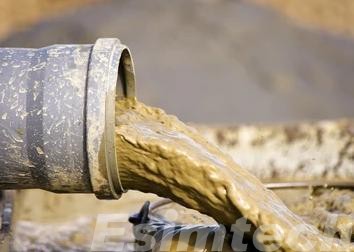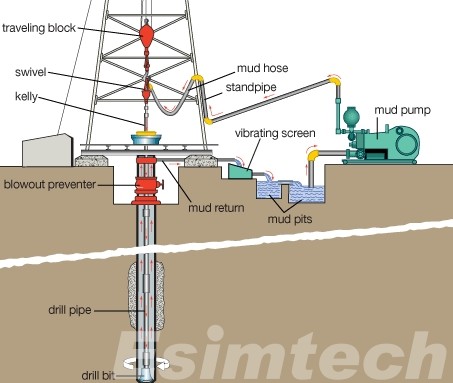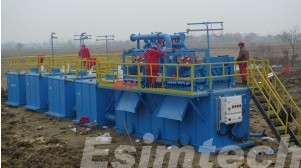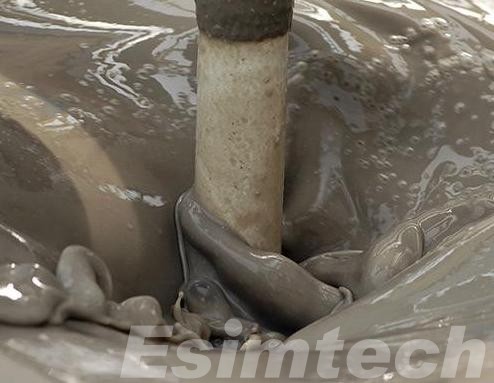The Impact of Drilling Mud on Wellbore Stability
Drilling mud, also known as drilling fluid, plays a critical role in the oil and gas industry, especially in maintaining wellbore stability. This article will talk about the significance of drilling mud, the mechanisms of wellbore instability, its primary roles in ensuring stability, the factors influencing its performance, and concludes with a summary of its overall impact.
What is Drilling Mud?

Drilling mud, or drilling fluid, is a complex mixture of liquids and solids engineered specifically for use in the oil and gas industry. It serves as a versatile fluid that performs multiple critical functions during the drilling process. Essentially, it’s a carefully balanced slurry designed to cool and lubricate the drill bit, transport rock cuttings to the surface, control wellbore pressures, and support the wellbore to prevent collapse.
The composition of drilling mud can vary widely based on the specific drilling conditions and challenges, but generally includes water, oil, or synthetic fluids as a base, along with various additives like clays, polymers, and weighting agents to tailor its properties for optimal performance.
Mechanisms of Wellbore Instability
Wellbore instability is a complex problem caused by the interaction between drilling fluid and surrounding rock formations. Several main mechanisms cause this problem:
1. Shear Failure
Shear failure occurs when the tangential stress exerted on the wellbore wall exceeds the rock’s shear strength. This typically happens in formations with low cohesion, such as shales or clays. Factors influencing shear failure include:
Mud weight: Insufficient mud weight can lead to underbalanced conditions, resulting in increased pore pressure and potential shear failure.
Drilling fluid properties: The rheological properties of the drilling fluid, such as viscosity and yield point, affect the shear stress exerted on the wellbore wall.
Rock properties: The strength and cohesion of the rock formation determine its susceptibility to shear failure.
2. Tensile Failure
Tensile failure arises when the rock is subjected to tensile stresses that exceed its tensile strength. This often occurs in formations with natural fractures or weaknesses. Factors contributing to tensile failure include:
Mud weight: Excessive mud weight can induce tensile stresses in the formation, leading to fracture initiation and propagation.
Formation stresses: The in-situ stress regime of the formation, including horizontal and vertical stresses, affects the likelihood of tensile failure.
Drilling practices: Aggressive drilling practices, such as high rates of penetration, can increase the risk of tensile failure.

3. Compressive Failure
Compressive failure happens when the rock surrounding the wellbore is subjected to compressive stresses beyond its compressive strength. This typically occurs in formations with low tensile strength but high compressive strength, such as sandstones and limestones. Factors influencing compressive failure include:
Mud weight: Insufficient mud weight can lead to underbalanced conditions, resulting in increased pore pressure and potential compressive failure.
Rock properties: The compressive strength and elastic modulus of the rock determine its resistance to compressive failure.
Drilling practices: Drilling practices that induce high compressive stresses, such as sidetracking or directional drilling, can increase the risk of compressive failure.
4. Hydrofracturing
Hydrofracturing occurs when the pressure exerted by the drilling fluid exceeds the formation’s fracture pressure, leading to the creation of hydraulic fractures. Factors contributing to hydrofracturing include:
Mud weight: Excessive mud weight can induce high formation pressures, leading to fracture initiation.
Formation properties: The presence of natural fractures and permeability of the formation influence the susceptibility to hydrofracturing.
Drilling practices: Rapid changes in mud weight or drilling rate can increase the risk of hydrofracturing.
Understanding these mechanisms is crucial for developing effective strategies to prevent wellbore instability and ensure successful drilling operations.
Main Role of Drilling Mud in Wellbore Stability
Drilling mud can play a role in maintaining wellbore stability throughout the entire drilling process. It mainly includes several key functions, each of which is essential for preventing wellbore failures and ensuring effective extraction of hydrocarbons. Next, let’s delve into these features.
1. Pressure Control
One of the primary functions of drilling mud is to maintain hydrostatic pressure within the wellbore. The mud column creates a pressure that counterbalances the formation pressure from the surrounding geological formations. This balance is crucial for preventing the influx of formation fluids, such as oil, gas, or water, into the wellbore. If the pressure is too low, it can lead to a kick (uncontrolled influx of formation fluids), which might escalate to a blowout. Conversely, excessive pressure can cause fracturing of the formation. Thus, maintaining the right hydrostatic pressure is key to stabilizing the wellbore and avoiding potentially hazardous situations.
2. Cuttings Removal
Drilling operations generate rock cuttings as the drill bit grinds through the formation. These cuttings must be efficiently carried to the surface to prevent their accumulation in the wellbore, which can lead to blockages and stuck pipe situations. Drilling mud, with its designed viscosity and density, facilitates the effective transport of these cuttings. The flow of mud not only lifts the cuttings but also cleans the wellbore wall, preventing the build-up of debris that could compromise wellbore stability.

3. Formation Support
The formation of a mud cake—a thin, impervious layer of drilling mud solids deposited on the wellbore wall—is a critical aspect of wellbore stability. This mud cake acts as a barrier between the wellbore and the formation, providing structural support to the wellbore walls. By sealing off permeable formations, the mud cake helps to prevent the loss of drilling fluid into the formation (known as lost circulation) and reduces the risk of wellbore collapse. The thickness and integrity of the mud cake can be adjusted by modifying the composition of the drilling mud, ensuring optimal formation support for varying geological conditions.
4. Lubrication and Cooling
Drilling mud plays a crucial role in lubricating the drill bit and drill string. As the drill bit rotates and grinds through the rock, it generates significant friction and heat. Drilling mud reduces this friction, which not only minimizes wear and tear on the equipment but also helps to dissipate the heat generated during drilling. Proper lubrication and cooling of the drill bit are essential to maintain its efficiency and extend its operational life, as well as to prevent damage to the wellbore.
5. Chemical Stabilization
Drilling mud is formulated with various chemical additives designed to stabilize the wellbore. These additives can include:
- Inhibitors: Prevent reactions between the drilling fluid and formation materials, such as clays, which might otherwise lead to swelling or weakening of the formation.
- Dispersants: Aid in keeping the cuttings and other solids suspended in the mud, preventing them from settling out and causing issues.
- Shale Stabilizers: Reduce the risk of shale swelling and disintegration, which can lead to instability and wellbore collapse.
By using these chemical agents, drilling mud can mitigate the effects of chemical interactions between the drilling fluid and the formation, thereby maintaining wellbore stability.
In short, drilling mud is not just a fluid used in the drilling process; It is also a multifunctional tool that helps enhance wellbore stability.
Common Factors Influencing Drilling Mud Performance
Drilling mud performance is influenced by a myriad of factors, each playing a vital role in ensuring the wellbore remains stable throughout the drilling operation. A deeper understanding of these factors can help optimize drilling fluid properties and mitigate potential problems. Here are some of the most critical factors:
1. Mud Composition
The composition of drilling mud is tailored to the specific needs of the drilling operation. The base fluid—water, oil, or synthetic—forms the foundation of the mud system. Each type of base fluid has its advantages and limitations:
- Water-based mud (WBM): Generally cheaper and environmentally friendly but may interact negatively with certain formations, leading to swelling or dispersion of clays.
- Oil-based mud (OBM): Provides excellent lubrication and stability, particularly in reactive shale formations, but is more expensive and poses environmental concerns.
- Synthetic-based mud (SBM): Offers a balance between WBM and OBM, with good performance in various formations and a lower environmental impact than OBM.
Additives such as clays, polymers, and weighting agents are mixed with the base fluid to enhance the properties of the mud. These additives help control the mud’s viscosity, density, filtration properties, and stability under various conditions.
2. Density and Viscosity
The density and viscosity of drilling mud are critical parameters that directly influence its performance:
- Density: The weight of the mud per unit volume is crucial for maintaining hydrostatic pressure within the wellbore. Adequate density prevents the influx of formation fluids and supports the wellbore walls. However, excessively high mud weight can fracture the formation, leading to lost circulation.
- Viscosity: The thickness of the mud affects its ability to lift cuttings to the surface. Higher viscosity improves cuttings transport but can increase friction and slow down the drilling process. Conversely, lower viscosity muds circulate more easily but may struggle to carry cuttings efficiently.

3. Temperature and Pressure Conditions
As drilling progresses to greater depths, the temperature and pressure conditions can significantly change:
- High Temperatures: Elevated temperatures can reduce the viscosity of the mud, necessitating the use of temperature-stabilizing additives. Some polymers and chemicals used in the mud may degrade at high temperatures, affecting mud performance.
- High Pressures: At greater depths, the increased pressure can alter the physical and chemical properties of the mud. Ensuring that the mud remains stable and effective under these conditions is critical for maintaining wellbore stability.
4. Formation Characteristics
The geological and chemical properties of the formation being drilled into can greatly influence how the drilling mud interacts with it:
- Porosity and Permeability: Highly porous and permeable formations may lead to fluid loss from the mud into the formation. Mud additives that form a thin, low-permeability filter cake on the wellbore wall are essential to minimize fluid loss.
- Clay Content: Formations with high clay content can react with water-based muds, causing clay swelling or dispersion. Using inhibitors or switching to oil-based or synthetic-based muds can help mitigate these issues.
- Rock Strength: The mechanical strength of the formation affects its stability under the stresses induced by drilling. Proper mud weight selection is necessary to prevent both shear and tensile failures of the formation.
5. Operational Parameters
The parameters of the drilling operation itself also play a significant role in the performance of the drilling mud:
- Drilling Speed: Faster drilling speeds can increase the amount of cuttings generated, requiring efficient mud circulation and solids control systems to manage the increased load.
- Circulation Rate: The rate at which drilling mud is circulated through the wellbore affects its ability to transport cuttings and maintain pressure. Optimal circulation rates ensure efficient cuttings removal and consistent pressure control.
- Use of Downhole Tools: Tools such as mud motors, rotary steerable systems, and measurement-while-drilling (MWD) devices can influence mud properties. For example, mud motors may require specific mud weights and viscosities to operate effectively.
Summary
Drilling mud is an essential component of the drilling process and is crucial for maintaining wellbore stability. Understanding the mechanism of wellbore instability and the role of drilling mud can help optimize its performance and prevent costly drilling problems.

